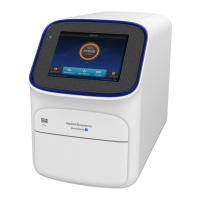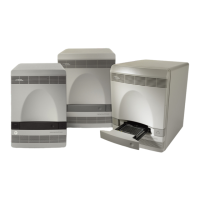In presence/absence experiments, wells that contain IPC blocking agent instead of
sample in the PCR reaction. No amplication should occur in negativ
e control-
blocked IPC wells because the reaction contains no sample and amplication of the
IPC is blocked. Previously called no amplication control (NAC).
In presence/absence experiments, wells that contain IPC template and buer or water
instead of sample. Only the IPC template should amplify in negative control-IPC
wells because the reaction contains no sample. Previously called IPC+.
See “negative control (NC)“ on page 187.
Molecules that are aached to the 3′ end of probes. When the probe is intact, the
nonuorescent quencher (NFQ) prevents the reporter dye from emiing uorescence
signal. Because the NFQ does not uoresce, it produces lower background signals,
resulting in improved precision in quantication. The minor groove binder (MGB)
increases the melting temperature (T
m
) of the probe without increasing its length,
allowing for the design of shorter probes.
Type of calibration in which the software collects data from the normalization
standards, then stores it in a normalization calibration le.
Either the C
t
Avg. of the target gene minus the C
t
Avg. of the endogenous control
(Comparative C
t
experiments), or the Q Avg. of the target divided by the Q Avg. of
the endogenous control (Relative Standard Curve experiments).
The relative standard curve equivalent of the ΔC
t
mean value found in Comparative
C
t
experiments (computed as the geometric mean).
The relative standard curve equivalent of the ΔC
t
SE value found in Comparative C
t
experiments (computed as the geometric standard error of the mean).
Fluorescence signal from the reporter dye normalized to the uorescence signal of the
passive reference dye (usually ROX
™
dye on Thermo Fisher Scientic instruments).
A measurement (such as a C
t
) that deviates signicantly from the measurement of the
other replicates for that same sample.
A dye that produces uorescence signal independent of PCR amplication, and that is
added to each reaction at a constant concentration. Because the passive reference
signal should be consistent across all wells, it is used to normalize the reporter dye
signal to account for non-PCR related uorescence uctuations caused by minor well-
to-well dierences in volume. Normalization to the passive reference signal generally
results in data with noticeably high precision among technical replicates.
An illustration of the grid of wells and assigned content in the plate or array card. The
number of rows and columns in the grid depends on the sample block that you use.
negative control-
blocked IPC wells
negative control-
IPC w
ells
no template
control (NTC)
nonfluorescent
quencher-minor
groove binder
(NFQ-MGB)
normalization
calibration
normalized
quantity
normalized
quantity mean
normalized
quantity SE
normalized
reporter (R
n
)
outlier
passive reference
plate layout
Limited product warranty
188
QuantStudio
™
6 and 7 Flex Real-Time PCR Systems v1.6 Maintenance and Administration Guide
